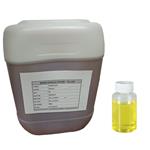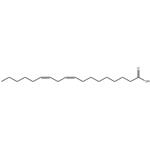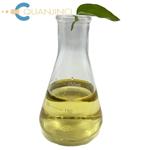- Linoleic acid
-

- $135.00 / 1kg
-
2024-03-29
- CAS:60-33-3
- Min. Order: 1kg
- Purity: 94.9%
- Supply Ability: 10 TONS
- Linoleic acid
-

- $5.00 / 1KG
-
2024-03-27
- CAS:60-33-3
- Min. Order: 1KG
- Purity: 98%
- Supply Ability: g-kg-tons, free sample is available
- Linolic acid
-

- $10.00 / 1kg
-
2023-11-29
- CAS:60-33-3
- Min. Order: 1kg
- Purity: 0.99
- Supply Ability: 1000000tons
|
| | Linoleic acid Chemical Properties |
| | Linoleic acid Usage And Synthesis |
| Linoleic acid and its function | Linoleic acid is unsaturated omega-6 fatty acid usually found in corn, safflower, and sunflower oils. As it cannot be synthesized in vivo and has a defined metabolic significance, Linoleic acid is accepted as an essentical nutrient. Linolenic acid gives rise to arachidonic acid, which is the major precursor of a series of bioactive metabolites called eicosanoids, which regulate physiological processes in large scale such as prostaglandins, thromboxane A2, prostacyclin I2, leukotriene B4 and anandamide providing the body anti-inflammatory, moisturizing and healing support.
In 1930, Scientist reported that the rats exhibited scaly skin lesions, impaired growth, tail necrosis, and renal degeneration by the lack of linoleic acid, and the return of this fatty acid to the animal’s diet cured the lesions. Administration of only 1 to 2% of dietary calories in the form of linoleic acid will support normal growth and development and prevent the clinical appearance of essential fatty acid deficiency (EFAD). Linoleic acid deficiency possibly happens in infants fed skimmed milk, in patients with chronic fat malabsorption, and in those undergoing total parenteral nutrition, which will cause poor growth and development in infants and dermatitis in adults.
| | Brief Introduction | Linoleic acid is named cis-9, 12-octadecadienoic acid, can also use △ to denote double bond, thus being named △ 9, 12-octadecadienoic acid. Alternatively, it can be simply expressed as 9C, 12C-18: 2 or C18: 2.
Linoleic acid in foods is important for human body to maintain many physiological functions such as the synthesis of phospholipids and other lipid metabolism, etc., being capable f significantly lower the effect of serum cholesterol. It can correct the growth arrest, skin and hair abnormalities, abnormal serum and adipose tissue composition of experimental animals due to lack of essential fatty acids. Lack of it in human beings can affect cell membrane function. Lack in infants can cause eczema. It is currently the major unsaturated fatty acids used to prevent and treat hyperlipidemia. Plant fat is the main source of linoleic acid, of which soybean oil, corn oil and cottonseed oil content is particularly rich. The content in vegetable oil (except palm oil), fish fat and poultry fat is also high. It is generally recommended that the amount of dietary linoleic acid should be equivalent to more than 2% to 3% of the total dietary calories.
| | Pharmaceutical effects | Linolenic acid is the unsaturated acids obtained from the extraction and vacuum distillation of the saponification product of soybean oil. It contains over 65% of pure linoleic acid as well as vitamin E being as an antioxidant. Linoleic acid can react with cholesterol to become esters, which is more easily transported, metabolized and excreted, thus reducing blood cholesterol levels. It can also reduce the triglycerides content in the blood. Unsaturated fatty acids may change the distribution of cholesterol in the body, making it deposited in the tissue outside the vessel wall, further reducing the cholesterol content of the vessel wall for preventing and treating atherosclerosis.
| | Linoleic acid sources and food |
Fatty acid
Double Bonds
Sources
Linoleic acid
n-6
Vegetable oils, margarines, grain
α- linolenic acid
Green leaves, linseed, soybean and canola oil
EPA, DHA
Marine animals, cod liver oil and fish oil
| | Production | Linoleic acid is present in the form of glycerides inside the animal body together with other fatty acids. The content in animal fat is generally low; for example, 1.8% iin butter, 6% in lard; some kinds of vegetable oils have high content such as 26% in peanut oil, and 15.8 in rape oil while the soybean fatty acids are mainly linoleic acid. The general composition of soybean fatty acids are as follows: oleic acid 15-33% linoleic acid 53-56% linolenic acid 5-9% palmitic acid 7-11% stearic acid and 2-6% Carbon 20- or more acids. The 0.3-3% soybean oil, will give approximately 5-10% of the oil foot and soap foot during the refining process. Half of the soya bean oil soap is useful fatty acids, while the fatty acids in the soaps are essentially the same as the fatty acid composition of the soya bean oil. Therefore, the use of soybean oil soap for extraction of linoleic acid is an important way to comprehensive utilize the soybean oil.
| | Description | Linoleic acid is an essential ω-6 polyunsaturated fatty acid (PUFA). It is the most abundant PUFA in a variety of foods, and dietary sources of linoleic acid include vegetable oils, meats, nuts, seeds, and eggs. Linoleic acid (30 μM) increases migration of IEC-6 rat intestinal epithelial cells in a wound healing assay. Rats fed a linoleate-deficient diet exhibit decreased body weight and an increased ratio of eicosatrienoate to arachidonate in liver and serum phospholipids compared with rats fed a control diet, as well as mild scaling of forepaw skin. | | Chemical Properties | Linoleic acid occurs as a colorless to light-yellow-colored oil. | | Chemical Properties | Liquid at room temperature, colorless | | Uses | Unsaturated μ-6 fatty acid Linoleic acid is involved in the production of quick-drying oils which are used in oil paints and varnishes. It is also used in beauty products due to its beneficial properties on the skin such as moisture retention. It is a key starting material for the synthesis of linoleyl alcohol and octadecanoic acid. It is used as a precursor of arachidonic acid (AA) and various prostaglandins. It may be used to improve the delivery and efficacy of anti-cancer drugs and in cancer protection. | | Uses | Linoleic acid(cis-9, cis-12-octadecadienoic acid), an essential fatty acid, can act as a radioprotective agent of BM while being toxic to certain tumor cells. | | Uses | linoleic acid (vitamin F) is also known as omega-6. An emulsifier, it is also cleansing, emollient, and skin conditioning. Some formulations incorporate it as a surfactant. Linoleic acid prevents dryness and roughness. A deficiency of linoleic acid in the skin is associated with symptoms similar to those characterizing eczema, psoriasis, and a generally poor skin condition. In numerous laboratory studies where a linoleic acid deficiency was induced, a topical application of linoleic acid in its free or esterified form quickly reversed this condition. In addition, there is some evidence in laboratory tests that linoleic acid may inhibit melanin production by decreasing tyrosinase activity and suppressing melanin polymer formation within melanosomes. Linoleic acid is an essential fatty acid found in a variety of plant oils, including soybean and sunflower. | | Production Methods | Linoleic acid is obtained by extraction from various vegetable oils
such as safflower oil. | | Definition | linoleic acid: A liquid polyunsaturatedfatty acid with two doublebonds, CH3(CH2)4CH:CHCH2-CH:CH(CH2)7COOH.Linoleic acid isabundant in plant fats and oils,e.g.linseed oil, groundnut oil,and soyabeanoil.It is an essential fatty acid. | | Definition | An unsaturated carboxylic
acid that occurs in LINSEED OIL and
other plant oils. It is used in making paints
and varnishes. | | Definition | ChEBI: An octadecadienoic acid in which the two double bonds are at positions 9 and 12 and have Z (cis) stereochemistry. | | General Description | Colorless to straw colored liquid. A polyunsaturated fatty acid essential to human diet. | | Air & Water Reactions | Sensitive to air and light. . Oxidizes across carbon double bonds | | Reactivity Profile | Linoleic acid reacts to neutralize bases. May react vigorously with oxidizing agents. May react exothermically with reducing agents to release hydrogen gas. | | Fire Hazard | Flash point data for Linoleic acid are not available. Linoleic acid is probably combustible. | | Pharmaceutical Applications | Linoleic acid is used in topical transdermal formulations, in
oral formulations as an absorption enhancer, and in topical
cosmetic formulations as an emulsifying agent, and in aqueous
microemulsions.It is also used in parenteral emulsions for total
parenteral nutrition and in nonprescription oral dietary supplements. | | Biochem/physiol Actions | Linoleic acid increases cell proliferation and gene expression of PPARα and its target genes such as acyl-CoA oxidase in primary duck hepatocytes . | | Safety | Linoleic acid is widely used in cosmetics and topical pharmaceutical
formulations, and is generally regarded as a nontoxic material. On
exposure to the eyes, skin, and mucous membranes, linoleic acid can
cause mild irritation. | | storage | Linoleic acid is sensitive to air, light, moisture, and heat. It should be
stored in a tightly sealed container under an inert atmosphere and
refrigerated. | | Incompatibilities | Linoleic acid is incompatible with bases, strong oxidizing agents,
and reducing agents. | | Regulatory Status | GRAS listed. Approved for use in foods in Europe and the USA. |
| | Linoleic acid Preparation Products And Raw materials |
|